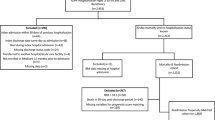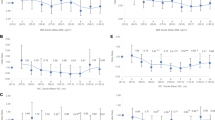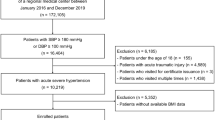Abstract
OBJECTIVE:
We investigated the documentation of obesity as a medical problem, and subsequent management recommendations, in patients after myocardial infarction (MI).
DESIGN:
We performed a cross-sectional analysis of a randomly selected sample of 627 patients discharged after an MI, from five US teaching hospitals between 1/1/01 and 12/31/02. Information was extracted from clinical notes using standardized definitions.
RESULTS:
Mean body mass index (BMI) was 31±13 kg/m2, which was documented in only 14% of patients and had to be calculated post hoc in the rest. Waist circumference and waist/hip ratio were not documented at all; 83% of patients were overweight, 55% obese, and 8% morbidly obese. In only 20% of patients with BMI≥30 kg/m2 was the diagnosis of obesity documented either as a current medical problem, as part of past medical history or as a final diagnosis. A dietary counseling was carried out in 61% of patients with BMI≥25 kg/m2 and in 61% of patients with BMI<25 kg/m2, P=0.96. Weight loss was described as part of the goals/plan at discharge in 7% of overweight and 9% of obese patients. There was no change in either the level of recognition of obesity (22 vs 19%, P=0.3) or in the proportion of obese patients for whom weight loss was described as part of the goals/plan at discharge (8 vs 10%, P=0.7) before (n=301) compared to after (n=326) the Call to Action in Obesity by the Surgeon General in December 2001.
CONCLUSION:
Obesity is underecognized, underdiagnosed and undertreated in persons with acute MI.
This is a preview of subscription content, access via your institution
Access options
Subscribe to this journal
Receive 12 print issues and online access
$259.00 per year
only $21.58 per issue
Buy this article
- Purchase on Springer Link
- Instant access to full article PDF
Prices may be subject to local taxes which are calculated during checkout
Similar content being viewed by others
References
World Health Organization (WHO). Obesity: preventing and managing the global epidemic. Report of a WHO Consultation on Obesity, Geneva, 3–5 June 1997.
Bray GA . Obesity: a time bomb to be defused. Lancet 1998; 352: 160–161.
Flegal KM, Carroll MD, Ogden CL, Johnson CL . Prevalence and trends in obesity among US adults, 1999–2000. JAMA 2002; 288: 1723–1727.
Mokdad AH, Serdula MK, Dietz WH, Bowman BA, Marks JS, Koplan JP . The continuing epidemic of obesity in the United States. JAMA 2000; 284: 1650–1651.
Melanson KJ, McInnis KJ, Rippe JM, Blackburn G, Wilson PF . Obesity and cardiovascular disease risk: research update. Cardiol Rev 2002; 9: 202–207.
Ezzati M, Lopez AD, Rodgers A, Hoorn SV, Murray CJL, and the Comparative Risk Assessment Collaborating Group. Selected major risk factors and global and regional burden of disease. Lancet 2002; 360: 1347–1360.
Eckel RH, Barouch WW, Ershow AG . Report of the National Heart, Lung, and Blood Institute—National Institute of Diabetes and Digestive and Kidney Diseases Working Group on the Pathophysiology of Obesity-Associated Cardiovascular Disease. Circulation 2002; 105: 2923–2928.
Mark AL, Correia ML, Rahmouni K, Haynes WG . Selective leptin resistance: a new concept in leptin physiology with cardiovascular implications. J Hyperten 2002; 20: 1245–1250.
Haynes WG, Morgan DA, Walsh SA, Sivitz WI, Mark AL . Cardiovascular consequences of obesity: role of leptin. Clin Exp Pharm Physiol 1998; 25: 65–69.
Eckel RH . Obesity and heart disease: a statement for healthcare professionals from the Nutrition Committee, American Heart Association. Circulation 1997; 96: 3248–3250.
Smith Jr SC, Blair SN, Bonow RO, Brass LM, Cerqueira MD, Dracup K, Fuster V, Gotto A, Grundy SM, Miller NH, Jacobs A, Jones D, Krauss RM, Mosca L, Ockene I, Pasternak RC, Pearson T, Pfeffer MA, Starke RD, Taubert KA . AHA/ACC Guidelines for preventing heart attack and death in patients with atherosclerotic cardiovascular disease: 2001 Update: a statement for healthcare professionals from the American Heart Association and the American College of Cardiology. Circulation 2001; 104: 1577–1579.
Lopez-Jimenez F, Jacobsen SJ, Reeder GS, Weston SA, Killian JM, Meverden R, Roger VL . Prevalence of risk factors for coronary disease in myocardial infarction in the community. J Am Coll Cardiol 2003; 41: 291-A.
US Department of Health and Human Services, Office of the Surgeon General. The Surgeon General's Call to Action to Prevent and Decrease Overweight and Obesity (Rockville, MD): US Department of Health and Human Services, Public Health Service, Office of the Surgeon General 2001.
Anonymous. Overweight, obesity, and health risk. National Task Force on the prevention and treatment of obesity. Arch Intern Med 2000; 160: 898–904.
Eckel RH, Krauss RM . American Heart Association call to action: obesity as a major risk factor for coronary heart disease. Circulation 1998; 97: 2099–2100.
Pi-Sunyer X . A clinical view of the obesity problem. Science 2003; 299: 859–860.
Yanovski SZ, Yanovski JA . Drug therapy: obesity. N Engl J Med 2002; 346: 591–602.
US Department of Health and Human Services. Healthy People 2000. National Health Promotion and Disease Prevention Objectives. DHHS Publication No. (PHS) 91-50213 1991.
Downey M . Results of expert meetings: obesity and cardiovascular disease. Obesity as a disease entity. Am Heart J 2001; 142: 1091–1094.
Your Medicare Coverage Home. http://www.medicare.gov/Coverage/Home.asp. Last time accessed June 6th 2003.
Bowerman S, Bellman M, Saltsman P, Garvey D, Pimstone K, Skootsky S, Wang HJ, Elashoff R, Heber D . Implementation of a primary care physician network obesity management program. Obes Res 2001; 9 (Suppl 4): 321S–325S.
Wooley SC, Wooley OW . Should obesity be treated at all? In: Stunkard AJ, Stellar E (eds) Eating and its disorders. Raven Press: New York, NY; 1984. pp 185–192.
Ernsberger P, Haskew P . Health implications of obesity: an alternative view. J Obes Weight Regul 1987; 6: 58–137.
Castelli WP . Cardiovascular disease and multifactorial risk: challenge of the 1980s. Am Heart J 1983; 106: 1191–1200.
Kushner RF . Barriers to providing nutrition counseling by physicians. Prev Med 1995; 24: 546–552.
Grizzard T . Undertreatment of obesity. JAMA 2002; 288: 2177.
Lamas GA, Pfeffer MA, Hamm P, Wertheimer J, Rouleau JL, Braunwald E . Do the results of randomized clinical trials of cardiovascular drugs influence medical practice? The SAVE Investigators. N Engl J Med 1992; 327: 241–247.
Profile of General Demographic Characteristics 200. http://www.census.gov/census2000/states/us.html. Last time accessed June 4th, 2003.
Acknowledgements
Dr Lopez-Jimenez was supported in part by the Harry B Graf Career Development Award in Preventive Cardiology from the American College of Cardiology. Dr Somers was supported by National Institutes of Health Grants HL-65176, HL-61560, HL-70602, HL-73211, and M01-RR-00585.
Author information
Authors and Affiliations
Corresponding author
Rights and permissions
About this article
Cite this article
Lopez-Jimenez, F., Malinski, M., Gutt, M. et al. Recognition, diagnosis and management of obesity after myocardial infarction. Int J Obes 29, 137–141 (2005). https://doi.org/10.1038/sj.ijo.0802831
Received:
Revised:
Accepted:
Published:
Issue Date:
DOI: https://doi.org/10.1038/sj.ijo.0802831
Keywords
This article is cited by
-
Mechanisms of Adverse Cardiometabolic Consequences of Obesity
Current Atherosclerosis Reports (2013)
-
Documentation of body mass index and control of associated risk factors in a large primary care network
BMC Health Services Research (2009)
-
Effect of Weight Loss on Predicted Cardiovascular Risk: Change in Cardiac Risk After Bariatric Surgery
Obesity (2007)



